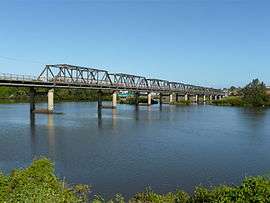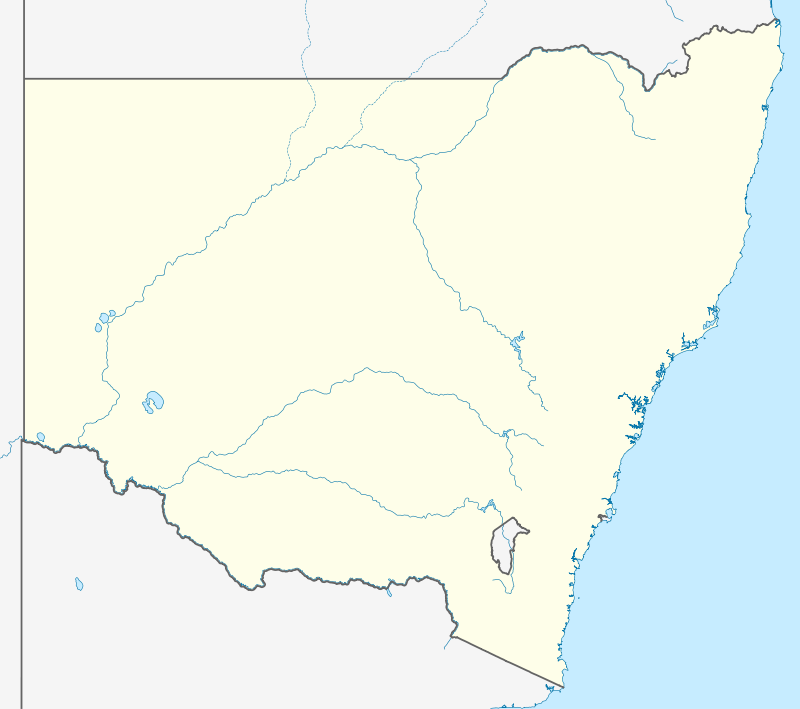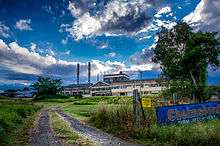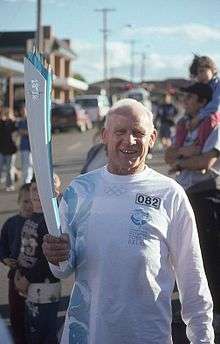Taree
Taree is a town on the Mid North Coast, New South Wales, Australia. Taree and nearby Cundletown were settled in 1831 by William Wynter.[2] Since then Taree has grown to a population of 26,381,[1] and is the centre of a significant agricultural district. It is 16 km from the Tasman Sea coast, and 317 km north of Sydney.[2] Taree can be reached by train via the North Coast Railway, and by the Pacific Highway. Taree railway station is on the North Coast line of the NSW TrainLink network. It is serviced by six NSW TrainLink trains daily: three heading to Sydney, another three heading North to Grafton, Casino or Brisbane. Taree is within the local government area of Mid-Coast Council, the state electorate of Myall Lakes and the Federal electorate of Lyne.
| Taree New South Wales | |||||||||
|---|---|---|---|---|---|---|---|---|---|
 The Martin Bridge, which carries traffic over the Manning River | |||||||||
 Taree | |||||||||
| Coordinates | 31°54′0″S 152°27′0″E | ||||||||
| Population | 26,381 (2018)[1] | ||||||||
| Established | 1831 | ||||||||
| Postcode(s) | 2430 | ||||||||
| Elevation | 5 m (16 ft) | ||||||||
| Location | |||||||||
| LGA(s) | Mid-Coast Council | ||||||||
| State electorate(s) | Myall Lakes | ||||||||
| Federal Division(s) | Lyne | ||||||||
| |||||||||
Name
The name Taree is derived from "tareebit", a Biripi word meaning tree by the river, or more specifically, the Sandpaper Fig (Ficus coronata).[2]
History
The Biripi were the indigenous people of what is now known as Taree. The Aboriginal population of the Manning River was relatively dense before colonisation by Europeans.[3]
In 1826, Assistant Surveyor Henry Dangar was instructed by John Oxley as Surveyor General (and a shareholder in the Australian Agricultural Company) to survey the land between Port Stephens and the Hastings River. During this expedition, Dangar identified that 'Harrington Lake' was a river with two entrances to the sea. Later in 1826, the river was named the Manning River by Robert Dawson for the Deputy Governor of the Australian Agricultural Company, William Manning.[4]
In 1829, Governor Darling proclaimed the division of the settlement of the colony of New South Wales into nineteen counties. The northern limit of the settlement was declared to be the Manning River.
Taree was laid out as a private town in 1854 by Henry Flett, the son-in-law of William Wynter who had originally settled the area in 1831. 100 acres (40 ha) had been set aside for the private township and 40 lots were initially sold. Taree was declared a municipality on 26 March 1885 and the first municipal council was elected by the residents.[5] In the early 1800s the road from Newcastle to Port Macquarie came via Gloucester and forded the river near Wingham. Boats could not go further upstream than this due to narrowing of the river and rapids. Hence a town formed at Wingham, about a day's ride from Gloucester. Timber getting, especially cedar, ensured goods were brought to Wingham and then shipped to Newcastle and beyond by boat. Coopernook similarly formed a local shipping hub. In 1844, the government of New South Wales had established Wingham as its administrative centre. When the North Coast railway line came through in 1913,[2] it ended initially at Taree. Even before the rest of the line was completed it became apparent that it was safer to send goods by rail to Newcastle and Sydney rather than hazarding the bar at the outlet to the river at Harrington where many ships had been lost. Although connected to the railway, sea transport continued to dominate along the North Coast until the 1930s. This changed when the Martin Bridge replaced the ferry across the Manning River in 1940.[2] River traffic significantly reduced after this, ensuring Taree's place as the centre of business.
The oldest surviving building in Taree is the old St Paul's Presbyterian Church, built-in 1869 in the Victorian Gothic Revival style, next door to the current building, in Albert Street.[2]
Heritage listings
Taree has a number of heritage-listed sites, including:
- North Coast railway: Taree railway station[6]
Climate
Taree experiences a humid subtropical climate (Köppen Climate Classification: Cfa).[7] Taree gets around 102.5 sunny days annually.
| Climate data for Taree (Robertson Street) | |||||||||||||
|---|---|---|---|---|---|---|---|---|---|---|---|---|---|
| Month | Jan | Feb | Mar | Apr | May | Jun | Jul | Aug | Sep | Oct | Nov | Dec | Year |
| Record high °C (°F) | 42.5 (108.5) |
46.2 (115.2) |
41.4 (106.5) |
37.0 (98.6) |
30.3 (86.5) |
27.6 (81.7) |
28.9 (84.0) |
31.4 (88.5) |
38.0 (100.4) |
40.1 (104.2) |
43.4 (110.1) |
42.7 (108.9) |
46.2 (115.2) |
| Average high °C (°F) | 29.0 (84.2) |
28.6 (83.5) |
27.3 (81.1) |
24.7 (76.5) |
21.5 (70.7) |
19.1 (66.4) |
18.5 (65.3) |
19.9 (67.8) |
22.7 (72.9) |
24.9 (76.8) |
26.7 (80.1) |
28.4 (83.1) |
24.3 (75.7) |
| Average low °C (°F) | 17.6 (63.7) |
17.6 (63.7) |
16.0 (60.8) |
13.0 (55.4) |
9.8 (49.6) |
7.3 (45.1) |
5.9 (42.6) |
6.4 (43.5) |
8.6 (47.5) |
11.5 (52.7) |
14.1 (57.4) |
16.4 (61.5) |
12.0 (53.6) |
| Record low °C (°F) | 9.3 (48.7) |
10.7 (51.3) |
7.0 (44.6) |
3.3 (37.9) |
−2.3 (27.9) |
−1.7 (28.9) |
−5 (23) |
−1.8 (28.8) |
−0.7 (30.7) |
0.6 (33.1) |
4.0 (39.2) |
8.0 (46.4) |
−5 (23) |
| Average rainfall mm (inches) | 118.9 (4.68) |
138.7 (5.46) |
149.5 (5.89) |
117.0 (4.61) |
96.8 (3.81) |
97.7 (3.85) |
73.9 (2.91) |
61.2 (2.41) |
60.2 (2.37) |
75.6 (2.98) |
86.6 (3.41) |
100.0 (3.94) |
1,178.8 (46.41) |
| Average rainy days | 10.7 | 11.2 | 12.4 | 10.5 | 9.4 | 8.9 | 7.4 | 7.8 | 7.6 | 9.4 | 9.8 | 10.5 | 115.6 |
| Average afternoon relative humidity (%) | 61 | 62 | 63 | 60 | 60 | 59 | 54 | 51 | 51 | 58 | 57 | 59 | 58 |
| Source: [8] | |||||||||||||
Economy



Of the 17,820 people resident in Taree; 3,319 worked full-time and 2,169 worked part-time. The unemployment rate is approximately double the national average. The most common industries of employment in retail, government and aged care. The median weekly household income is $719. This compares with a national average of $1,234. A plurality (35.4%) of children live in families with no one in employment.[9] 41.3% of households have a gross weekly income of less than $600; this is approximately half the national average.
Demographics
In the 2016 Census, there were 25,852 people in Taree. The median age in Taree is 46. 9.1% of the population is Aboriginal or Torres Strait Islander, with the average age amongst this group being 20. Taree has a significantly higher proportion of people aged 65+; with 25.5% of people over 65. This compares with a national average of 15.8%. 4.1% of residents are aged 85+, more than double the national average of 2.1%.
84.3% of people were born in Australia. The next most common countries of birth were England 2.3%, New Zealand 0.8% and Philippines 0.4%. 90.0% of people spoke only English at home.
The most common responses for religion were Anglican 28.5%, No Religion 23.4% and Catholic 17.5%.[10]
Education
There are several public schools in the Taree area including Taree Public School, Taree High School, Taree West Public School, Manning Gardens Public School, Chatham Public School, Chatham High School, and Cundletown Public School.
Private schools in and around Taree include Manning District Adventist School, Tinonee, Manning Valley Anglican College, Cundletown, Taree Christian College, Kolodong, St Joseph's Primary School, and St Clare's High School.
Several post-secondary education and training facilities have a presence in Taree: the North Coast Institute of TAFE, Taree Community College, the Australian Technical College - Manning Valley Campus.
Media

Newspapers
The Manning River Times[11] is based in Taree.
Television
All major digital-only television channels are available in Taree. The networks and the channels they broadcast are listed as follows:
- Prime7, 7Two, 7mate, 7flix. Seven Network affiliated channels.
- Nine (NBN Television), 9Go! and 9Gem, 9Life. Nine Network owned channels.
- WIN Television, 10 Bold and 10 Peach. Network Ten affiliated channels.
- ABC, ABC Comedy, ABC Me and ABC News, part of the Australian Broadcasting Corporation.
- SBS, SBS Viceland, SBS Food and NITV, part of the Special Broadcasting Service.
Of the three main commercial networks:
- Prime7 News airs a half-hour local news bulletin for the North Coast at 6 pm each weeknight. It is broadcast from studios in Canberra with reporters based at a local newsroom in the city.
- NBN Television airs NBN News, a regional hour-long program including opt-outs for the Mid North Coast, every night at 6 pm. It is broadcast from studios in Newcastle with reporters based at a local newsroom in the city.
- WIN Television airs short local news updates throughout the day, broadcast from its Wollongong studios.
Radio
There are four local radio stations, commercial stations 2RE and Max FM and community stations 2BOB and 2TLP.
The ABC broadcasts Triple J (96.3FM), ABC Classic FM (98.7FM), Radio National (97.1FM) and ABC Mid North Coast (95.5FM and 756AM) [12] into Taree.
Rhema FM Manning Great Lakes broadcasts from studios in nearby Wingham and Racing Radio is also broadcast to Taree.
Tourism

A local tourist attraction is a building called "The World's Largest Oyster", also called "The Big Oyster".[2] Big Things are a common form of tourist attraction in Australia. Like the Big Merino and Big Banana, the 'Oyster' is an artifact based on local produce; the Manning River produced 1,752,000 oysters during 2013.[13] The Big Oyster was an unsuccessful business venture, known to the locals as a 'Big Mistake', and is now home to a motor dealership.
The Manning Entertainment Centre was built in the 1980s as the cultural centre of the district. It seats 505 people[14] and has previously presented artists such as the Sydney Symphony Orchestra,[15] the Australian Ballet[16] and Dame Joan Sutherland.[17] Local performers, including the district eisteddfod and local amateur dramatic societies, use it to provide cultural opportunities for the local community.
Located next to the Entertainment Centre and the Visitor Information Centre at the northern entrance to Taree is the Manning Aquatic and Leisure Centre. This facility includes a 25-metre indoor heated pool with slippery dip and a 50-metre outdoor pool and soon after the time of opening had the second most expensive pool entrance fee in Australia, the most expensive being a pool in Perth, Western Australia. The Aquatic Centre was built in the late 1990s – early 2000s to replace the Taree Pool, which has been redeveloped into a public park with outdoor stage.[18]
The Manning Regional Art Gallery is located in a cottage-style building next to Taree Public School. The art gallery hosts a changing selection of works by local artists and visiting exhibitions.
Nearby towns include historic Wingham, Tinonee, and the beachside town of Old Bar.
Annual events
January
Events in the NSW Rowing Association Annual Pointscore Rowing Regatta are held at Endeavour Place in Taree during the third week of January. This Regatta runs over three days (Friday to Sunday) and consists of over 200 races with more than 500 competitors travelling from many parts of New South Wales to compete.[19][20]
The Manning River Summer Festival runs throughout the month of January, incorporating the town's New Year's celebrations, a "Family Fun Day" in Queen Elizabeth Park on Australia Day, and also vide variety of cultural events.
March / April
The Easter Powerboat Classic is held on the Manning River near Queen Elizabeth Park during the Easter Long Weekend. Events start on Friday morning and feature the Stuart Doyle Cup on Saturday and the Ken Warby time trials midday Saturday and Sunday.
August
The Taree Gold Cup is a prestigious horse racing event held at the Bushland Drive Racecourse.
October
The Taree Annual Show is held the second weekend in October. It consists of a sideshow, precision driving team, rodeo events, and cattle and livestock judging.
Notable residents

Notable residents that were born in or have a connection with Taree include:
- Matt Adamson, rugby league footballer of the 1990s and 2000s
- Murray Batchelor, mathematical physicist
- Troy Bayliss, professional motorcycle racer
- Aaron Bird, cricketer
- Sir Leslie Boyce KStJ, British Conservative Party politician
- David Boyd rugby league footballer of the 1980s and 1990s
- Sir Dick Boyer KBE, former Chairman of the Australian Broadcasting Commission. The Boyer Lectures are named in his honour.[21]
- Kasey Brown, professional squash player
- Danny Buderus, rugby league footballer who has played in the 1990s, 2000s and 2010s, and Australia captain
- Coral Buttsworth, former tennis player
- John H. Coates, mathematician
- Boyd Cordner, rugby league footballer who plays for the Sydney Roosters in the NRL.
- Damian Cudlin, professional motorcycle racer
- Daniel Dumas, rugby league footballer who played in the 2000s
- Scott Dureau, rugby league footballer who has played in the 2000s and 2010s
- Peter Gallagher, rugby league footballer of the 1950s and 1960s
- Josh Graham, rugby union and rugby league footballer who has played in the 2000s and 2010s
- Ben Harris, rugby league footballer who has played in the 2000s and 2010s
- Liz Hayes, television reporter
- Dr Ken Henry AC, a former Secretary to The Treasury
- Henry Kendall, poet
- Leigh Marning, rhythmic gymnast and contortionist
- Lewis Martin, politician
- Latrell Mitchell, rugby league footballer who has played in the 2010s, who has played for the Sydney Roosters in the National Rugby League.
- Ian Moffitt, former journalist and author
- Jarrod Mullen, rugby league footballer who has played in the 2000s and 2010s
- Les Murray AO, poet
- Jade North, (soccer) association footballer
- Erin Osborne, cricketer who plays for the Southern Stars and NSW Breakers
- Stewart Pike OAM, paralympic swimmer
- Ian Ruff bronze medal in the Sailing 470 class at the 1976 Summer Olympics in Montreal, along with his partner Ian Brown
- Michael Sullivan, rugby league footballer who played in the 2000s
- Amanda Thane, operatic soprano
- Clem Tisdell, economist
- Mark Vaile , former Deputy Prime Minister and National Party leader
- Oenone Wood, cyclist
- Adam Woolnough, rugby league footballer who has played in the 2000s and 2010s
See also
- List of cities in Australia
- Taree Airport
- List of World's Largest Roadside Attractions
References
- "3218.0 – Regional Population Growth, Australia, 2017-18: Population Estimates by Significant Urban Area, 2008 to 2018". Australian Bureau of Statistics. Australian Bureau of Statistics. 27 March 2019. Retrieved 25 October 2019. Estimated resident population, 30 June 2018.
- "Taree". The Age website. The Age Company Ltd. 16 August 2007. Retrieved 7 October 2008.
- Ramsland, John (2001). Custodians of the Soil. Taree: Greater Taree City Council. p. 16. ISBN 0-9579357-0-6.
- The Present State of Australia by Robert Dawson, page 372
- "Taree, a short factual history 1854-1954: a century of progress", Taree Centenary Celebrations Committee, 1954
- "Taree Railway Station group". New South Wales State Heritage Register. Office of Environment and Heritage. H01264. Retrieved 18 May 2018.
- "Climate statistics for Australian locations". www.bom.gov.au. Retrieved 13 September 2016.
- "Taree (Robertson St)". Climate statistics for Australian locations. Bureau of Meteorology. Retrieved 9 July 2013.
- http://www.censusdata.abs.gov.au/census_services/getproduct/census/2011/quickstat/UCL113020?opendocument&navpos=220
- Australian Bureau of Statistics (27 June 2017). "Taree". 2016 Census QuickStats. Retrieved 30 November 2017.

- "Home page". Manning River Times. Fairfax Media. Retrieved 13 October 2013.
- "Home page". ABC Mid North Coast NSW. Australian Broadcasting Corporation. Retrieved 13 October 2013.
- Parker, Sarah (5 June 2013). "Plan for the future health of Manning oyster industry". Manning River Times. Retrieved 13 October 2013.
- "Archived copy". Archived from the original on 20 March 2012. Retrieved 14 August 2012.CS1 maint: archived copy as title (link)
- http://www.manningrivertimes.com.au/news/local/news/general/sydney-symphony-brings-its-magic-to-taree/2575968.aspx
- "Archived copy". Archived from the original on 26 August 2013. Retrieved 14 August 2012.CS1 maint: archived copy as title (link)
- "Archived copy". Archived from the original on 12 October 2009. Retrieved 14 August 2012.CS1 maint: archived copy as title (link)
- "Archived copy". Archived from the original on 21 April 2013. Retrieved 14 February 2013.CS1 maint: archived copy as title (link)
- "Rowing NSW". regattas.rowingnsw.asn.au. Retrieved 5 May 2016.
- "Rowing NSW". regattas.rowingnsw.asn.au. Retrieved 5 May 2016.
- Bolton, G. C. "Boyer, Sir Richard James Fildes (1891–1961)". Australian Dictionary of Biography. National Centre of Biography, Australian National University. Retrieved 14 October 2013.
External links
| Wikimedia Commons has media related to Taree, New South Wales. |
- "Manning River catchments" (map). Office of Environment and Heritage. Government of New South Wales.
- "World's Largest Oyster" - picture
- Greater Taree City Council website
- Manning River Times